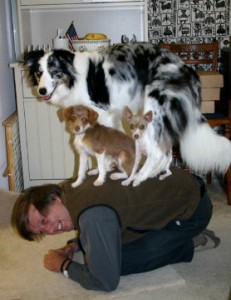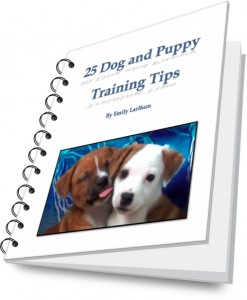by Emily Larlham
 You should never ignore behaviors your dog or puppy does that you find “undesirable” if the behaviors are self-reinforcing. This is because by practicing the behaviors the dog will find them reinforcing and be more likely to continue doing them in the future. By repetition the “undesired” behavior attains a reinforcement history, meaning it will be more likely to happen again in the future. Even though ignoring an attention-seeking behavior is a great way to extinguish the behavior, only ignoring undesirable attention seeking behaviors, such as jumping or barking rather than doing any training can get you into trouble. This is because the dog might offer another unwanted behavior in the place of the one you wanted to get rid of when you’re ignoring the dog. An example: If you ignored your puppy for jumping, and didn’t train the puppy what you wanted him to do instead, he could possibly start jumping higher and harder, barking or biting your leg to get your attention instead. It would never occur to a young puppy to sit calmly to get your attention without prior training, so by teaching the dog what you want him to do first, it gives him a behavior to offer that you like when the one you don’t like is not working for him.
You should never ignore behaviors your dog or puppy does that you find “undesirable” if the behaviors are self-reinforcing. This is because by practicing the behaviors the dog will find them reinforcing and be more likely to continue doing them in the future. By repetition the “undesired” behavior attains a reinforcement history, meaning it will be more likely to happen again in the future. Even though ignoring an attention-seeking behavior is a great way to extinguish the behavior, only ignoring undesirable attention seeking behaviors, such as jumping or barking rather than doing any training can get you into trouble. This is because the dog might offer another unwanted behavior in the place of the one you wanted to get rid of when you’re ignoring the dog. An example: If you ignored your puppy for jumping, and didn’t train the puppy what you wanted him to do instead, he could possibly start jumping higher and harder, barking or biting your leg to get your attention instead. It would never occur to a young puppy to sit calmly to get your attention without prior training, so by teaching the dog what you want him to do first, it gives him a behavior to offer that you like when the one you don’t like is not working for him.
This video below is an example of how to teach a puppy not to jump up by setting up training sessions to teach the puppy an alternate response instead of jumping up. So that when ignored, the puppy offers behaviors you like rather than other doggie behaviors instead of jumping:
http://www.youtube.com/watch?v=lC_OKgQFgzw
In my opinion, teaching the dog what you do want him to do first, reinforcing him for behaviors that you like that he already does, interrupting unwanted behaviors, and preventing the unwanted behaviors from happening is the key to successful training and reliable behavior management.
Interrupting behavior does not have to be physically or psychologically intimidating. You can use a positively reinforced recall, attention noise, or “leave it” cue to call your dog away from something and happily redirect him to something else. This means that you don’t get the side effects of using punishment when managing behaviors you don’t like!
Here is a video tutorial on how to train an attention noise to interrupt unwanted behavior:
http://www.youtube.com/watch?v=TBvPaqMZyo8
Let’s imagine my puppy is chewing on a wall, and I call him over to me with a previously trained recall, and then redirect him to a chew toy on the floor. The dog will be less likely to chew the wall in the future because he didn’t get to continue the positively reinforcing action. If the dog has been chewing on the wall for 10 minutes before I notice, however, a reinforcement history will already have begun, and a lot more training will be necessary to extinguish the behavior. This is why proactive behavior management in puppies is so important. Preventing puppies from starting undesirable habits in their first weeks at home will save you immeasurable amounts of training down the line.
Interrupting undesirable behaviors is just one piece in the training puzzle! You have GOT to reinforce your dog for doing what you WANT him to do to replace the undesirable behavior. Keep in mind that if you tend to ignore your dog and only pay attention to him when he is doing an undesirable behavior, you will be training him to do exactly what you do not want by rewarding him with your attention whenever the behavior occurs. The GOAL is to manage, train, and reward your dog’s desirable behaviors, and when things don’t go according to plan, interrupt the unexpected undesirable behaviors. You need to create a training plan that sets your dog up to succeed.
If your dog steals your underwear and runs around the house with them to get your attention, along side interrupting this behavior, you have got to reinforce your dog with your attention when he is calm and doing NOTHING. When your dog is lying at your feet quietly, reinforce this with MORE attention than when he runs off with your underwear. This can be counterintuitive at first, but it is crucial. Lavish attention on your dog when he is doing something you deem desirable, even if that something is just resting calmly, and not when he runs into the room tossing your underwear about in front of your house guests.
A lot of trainers will tell you to just ignore attention-seeking behaviors (without training the dog what you want him to do first). Doing so, however, can cause side effects like frustration, aggression, and extinction bursts. Extinction bursts are when the dog will start to offer the behavior you don’t like at higher, more intense levels. For example, your dog’s nudging you to get your attention can turn into nipping out of frustration if you simply ignore it.
25 Dog and Puppy Training Tips:
For each month of the year, I will release 2 training tips that will be accessible for free at dogmantics.com. If you simply cannot wait for the information to be published online, you can buy the collection of all 25 training tips in an ebook format here: 25 Dog and Puppy Training Tips
This is a list of all the tips included in the ebook, and that will be eventually available online:
- Teaching a dog previously kept outside to be calm inside the house
- The problem with ignoring unwanted behaviors
- Fading a lure
- Adding a verbal cue or changing a cue
- Dogs and babies
- Socializing tips- Our world can be a scary place!
- What to do if your puppy bites you OUTSIDE of a training session
- Changing your thinking from “I don’t like” to “I need to work on”
- What to use as reinforcement
- Treat deliveries
- Teaching your puppy appropriate greetings on leash
- Teaching “All done” for training sessions and dinnertime manners
- Variety is the spice of life… and training!
- Teaching your puppy to walk off leash
- Don’t let your dog free feed
- Don’t only work on one behavior at a time
- Separation training tips
- Monkey see, monkey do- Take advantage of social facilitation
- Always remember to release your dog!
- The importance of handling
- Chewing
- Teaching “Drop” and “Get it”
- What to do if your puppy sits and refuses to budge on a walk
- Generalizing
- Training your dog to do absolutely… NOTHING!
